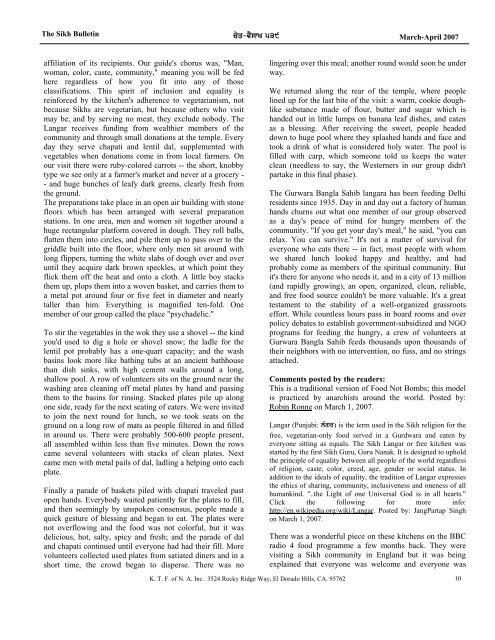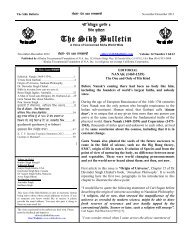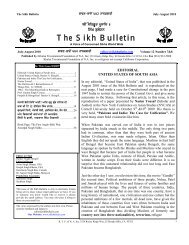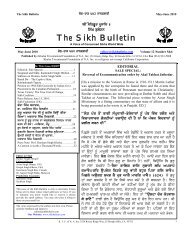Create successful ePaper yourself
Turn your PDF publications into a flip-book with our unique Google optimized e-Paper software.
<strong>The</strong> <strong>Sikh</strong> <strong>Bulletin</strong> cyq-vYswK 539 March-April 2007<br />
affiliation of its recipients. Our guide's chorus was, "Man,<br />
woman, color, caste, community," meaning you will be fed<br />
here regardless of how you fit into any of those<br />
classifications. This spirit of inclusion and equality is<br />
reinforced by the kitchen's adherence to vegetarianism, not<br />
because <strong>Sikh</strong>s are vegetarian, but because others who visit<br />
may be, and by serving no meat, they exclude nobody. <strong>The</strong><br />
Langar receives funding from wealthier members of the<br />
community and through small donations at the temple. Every<br />
day they serve chapati and lentil dal, supplemented with<br />
vegetables when donations come in from local farmers. On<br />
our visit there were ruby-colored carrots -- the short, knobby<br />
type we see only at a farmer's market and never at a grocery -<br />
- and huge bunches of leafy dark greens, clearly fresh from<br />
the ground.<br />
<strong>The</strong> preparations take place in an open air building with stone<br />
floors which has been arranged with several preparation<br />
stations. In one area, men and women sit together around a<br />
huge rectangular platform covered in dough. <strong>The</strong>y roll balls,<br />
flatten them into circles, and pile them up to pass over to the<br />
griddle built into the floor, where only men sit around with<br />
long flippers, turning the white slabs of dough over and over<br />
until they acquire dark brown speckles, at which point they<br />
flick them off the heat and onto a cloth. A little boy stacks<br />
them up, plops them into a woven basket, and carries them to<br />
a metal pot around four or five feet in diameter and nearly<br />
taller than him. Everything is magnified ten-fold. One<br />
member of our group called the place "psychadelic."<br />
To stir the vegetables in the wok they use a shovel -- the kind<br />
you'd used to dig a hole or shovel snow; the ladle for the<br />
lentil pot probably has a one-quart capacity; and the wash<br />
basins look more like bathing tubs at an ancient bathhouse<br />
than dish sinks, with high cement walls around a long,<br />
shallow pool. A row of volunteers sits on the ground near the<br />
washing area cleaning off metal plates by hand and passing<br />
them to the basins for rinsing. Stacked plates pile up along<br />
one side, ready for the next seating of eaters. We were invited<br />
to join the next round for lunch, so we took seats on the<br />
ground on a long row of mats as people filtered in and filled<br />
in around us. <strong>The</strong>re were probably 500-600 people present,<br />
all assembled within less than five minutes. Down the rows<br />
came several volunteers with stacks of clean plates. Next<br />
came men with metal pails of dal, ladling a helping onto each<br />
plate.<br />
Finally a parade of baskets piled with chapati traveled past<br />
open hands. Everybody waited patiently for the plates to fill,<br />
and then seemingly by unspoken consensus, people made a<br />
quick gesture of blessing and began to eat. <strong>The</strong> plates were<br />
not overflowing and the food was not colorful, but it was<br />
delicious, hot, salty, spicy and fresh; and the parade of dal<br />
and chapati continued until everyone had had their fill. More<br />
volunteers collected used plates from satiated diners and in a<br />
short time, the crowd began to disperse. <strong>The</strong>re was no<br />
lingering over this meal; another round would soon be under<br />
way.<br />
We returned along the rear of the temple, where people<br />
lined up for the last bite of the visit: a warm, cookie doughlike<br />
substance made of flour, butter and sugar which is<br />
handed out in little lumps on banana leaf dishes, and eaten<br />
as a blessing. After receiving the sweet, people headed<br />
down to huge pool where they splashed hands and face and<br />
took a drink of what is considered holy water. <strong>The</strong> pool is<br />
filled with carp, which someone told us keeps the water<br />
clean (needless to say, the Westerners in our group didn't<br />
partake in this final phase).<br />
<strong>The</strong> Gurwara Bangla Sahib langara has been feeding Delhi<br />
residents since 1935. Day in and day out a factory of human<br />
hands churns out what one member of our group observed<br />
as a day's peace of mind for hungry members of the<br />
community. "If you get your day's meal," he said, "you can<br />
relax. You can survive." It's not a matter of survival for<br />
everyone who eats there -- in fact, most people with whom<br />
we shared lunch looked happy and healthy, and had<br />
probably come as members of the spiritual community. But<br />
it's there for anyone who needs it, and in a city of 13 million<br />
(and rapidly growing), an open, organized, clean, reliable,<br />
and free food source couldn't be more valuable. It's a great<br />
testament to the stability of a well-organized grassroots<br />
effort. While countless hours pass in board rooms and over<br />
policy debates to establish government-subsidized and NGO<br />
programs for feeding the hungry, a crew of volunteers at<br />
Gurwara Bangla Sahib feeds thousands upon thousands of<br />
their neighbors with no intervention, no fuss, and no strings<br />
attached.<br />
Comments posted by the readers:<br />
This is a traditional version of Food Not Bombs; this model<br />
is practiced by anarchists around the world. Posted by:<br />
Robin Ronne on March 1, 2007.<br />
Langar (Punjabi: lMgr) is the term used in the <strong>Sikh</strong> religion for the<br />
free, vegetarian-only food served in a Gurdwara and eaten by<br />
everyone sitting as equals. <strong>The</strong> <strong>Sikh</strong> Langar or free kitchen was<br />
started by the first <strong>Sikh</strong> Guru, Guru Nanak. It is designed to uphold<br />
the principle of equality between all people of the world regardless<br />
of religion, caste, color, creed, age, gender or social status. In<br />
addition to the ideals of equality, the tradition of Langar expresses<br />
the ethics of sharing, community, inclusiveness and oneness of all<br />
humankind. "..the Light of one Universal God is in all hearts."<br />
Click the following for more info:<br />
http://en.wikipedia.org/wiki/Langar. Posted by: JangPartap Singh<br />
on March 1, 2007.<br />
<strong>The</strong>re was a wonderful piece on these kitchens on the BBC<br />
radio 4 food programme a few months back. <strong>The</strong>y were<br />
visiting a <strong>Sikh</strong> community in England but it was being<br />
explained that everyone was welcome and everyone was<br />
K. T. F. of N. A. Inc. 3524 Rocky Ridge Way, El Dorado Hills, CA. 95762 10
















